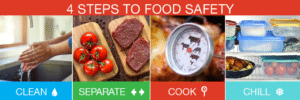Thursday, March 21, 2019

National Nutrition Month® is an annual nutrition education and information campaign created by the Academy of Nutrition and Dietetics. The campaign, celebrated each year during the month of March, focuses attention on the importance of making informed food choices and developing sound eating and physical activity habits.
One important component of nutrition is food safety. You know to wash your hands before eating — but many people aren’t aware of other common kitchen mistakes that can cause illness. The Academy of Nutrition and Dietetics encourages everyone to practice food safety before, during and after preparing your meals.
Keep It Clean
- Always was your hands with soapy water for at least 20 seconds before and after handling food. Wash your hands after handling raw meat and poultry to avoid spreading germs through juices
- Wash fruits and vegetables, but don’t wash meat and poultry prior to cooking to avoid spreading possibly harmful bacteria to your sink and surrounding kitchen areas
- Clean your counter tops with hot, soapy water. Use paper towels or disinfectant wipes, instead of washcloths or sponges, which can harbor bacteria
- Take apart small kitchen appliances, such as blenders and can openers, to clean them. Allow them to completely air dry before putting them away. Clean your refrigerator every few weeks to rid it of potentially dangerous residue from raw foods. Rid your refrigerator of leftovers after four days. When in doubt, throw it out
Cook It Right
- Using a food thermometer is the only real way to know if meat is done. It can help you avoid under-or over- cooking food by assessing the internal temperature
- Insert the thermometer into the thickest part of the meat, without it touching the bones or the bottom of the pan, to avoid getting a false reading. Then clean your thermometer with hot, soapy water after each use
Keep It Hot or Cold
- Keep hot foods hot and cold foods cold
- Avoid letting your food become lukewarm because that’s the temperature where microbes can multiply quickly
- Divide hot food into shallow containers to cool faster
- Refrigerate perishable foods within two hours — or within one hour during warmer weather
- Do not thaw frozen foods on the counter. Instead, thaw frozen foods in the refrigerator, in cold water or in the microwave. Harmful foodborne pathogens multiply rapidly when foods are in the temperature danger zone between 40° F and 140° F
Store It Right
- Store foods in the correct area of the refrigerator
- To minimize the risk of raw juices dripping into other foods, put cooked and ready-to-eat foods at the top and raw meats and poultry at the bottom. Plus, place raw meats in a container to catch any drips
- Store food in containers or wrapped with plastic or foil to prevent cross contamination. Take a tip from the pros and label and date foods to keep track of their freshness
Food borne illness can affect anyone. However, pregnant women, infants and young children, older adults, and people with weakened immune systems from medical conditions are more likely to experience severe illness as a result of food borne illness. It is important to know about food safety and to make sure you are being safe in your kitchen when preparing food for yourself and others!
Other Resources for Food Safety & Nutrition:
Safe Microwaving
Don’t Wing It – Practice Safe Poultry Handling
The Core Four Practices
Fight BAC!
Choose My Plate
Is My Food Safe? App available in the App Store and Google Play
Source:
Academy of Nutrition and Dietetics

